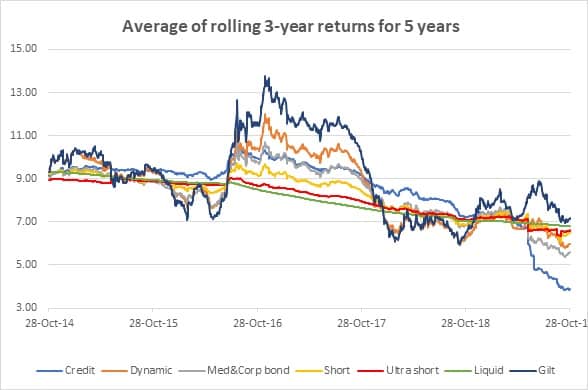Please note that debt fund taxation has changed with effect from July 2024. Please refer to this article for updated tax rules.
The last two years of turmoil in the debt fund space may have left you wondering what returns to expect from debt funds. Will debt funds beat FD? Or would their returns hover somewhere around their yield (yield to maturity) as promised by some? Are double-digit returns possible in debt? We try to provide answers to these (and bust some misconceptions in the process) by analyzing data across those debt fund categories that are popular among investors.

We analyzed past data – including a rate increase (not a high one) and rate decrease period and included one of the worst periods (last 1 year) for debt in terms of credit defaults – thus, broadly covering scenarios that impact debt returns. We took 1-year returns rolled daily for the past 3 years (spanning 4 years) and 3-year returns rolled daily for the past 5 years (spanning 8 years). It is noteworthy that when we talk about averages. That means there could be periods of higher or lower returns than the average. And there could be funds with higher or lower returns than the average mentioned.
Use this analysis to set more realistic expectations from debt funds instead of a vague 8% or 9% return you may have in mind.
Reality in the short term
Had you locked into 1-year FDs between 2015-19, you would have got an interest of 7% on an average (pre-tax). Now look at table 1 below: The average returns of the various fund categories might seem to suggest that you managed this return with debt funds as well. But not really.
- None of the fund categories steadily
managed to beat FD returns (6.9%) over 1-year periods. In fact, most of the
times, funds did not manage above 7% returns over 1-year time frames (see the
row ‘% of times >7% in table 1). - Low-volatile, low duration funds
such as liquid, ultra-short term and partly short duration funds managed over
6% returns almost all the time. But the other categories, which are either
volatile due to interest rate movements (dynamic bond, corporate bond, gilt) or
have credit risk struggled to generate 7% returns steadily over 1-year time
frames. - The minimum returns column will tell
you how worse it can get in each category. You will see that categories such as
gilt, dynamic bond or credit risk have declined or remained flat over shorter
time frames.
Please remember, for less than 3-year periods, there is no tax edge (unless you do a SWP). So, looking at pre-tax returns is important.
Table 1- 1-year returns rolled for 3 years
| Liquid | Ultra-short | Short duration | Med. dur & Corp bond | Dynamic Bond | Gilt | Credit Risk | |
| Min returns (%) | 6.62 | 5.90 | 3.97 | 1.13 | 0.34 | -1.38 | 0.35 |
| Max returns (%) | 7.77 | 8.58 | 10.58 | 12.82 | 15.44 | 17.82 | 11.01 |
| Avg. returns (%) | 6.95 | 6.98 | 6.93 | 7.34 | 7.07 | 7.90 | 6.26 |
| Std dev | 0.29 | 0.70 | 1.68 | 2.33 | 3.84 | 5.69 | 2.96 |
| % of times >7% | 32.42 | 41.15 | 44.49 | 50.41 | 46.66 | 55.24 | 40.00 |
| % of times >6% | 99.89 | 98.39 | 70.11 | 68.58 | 56.62 | 62.99 | 48.52 |
Period ending Oct-19. 1. Ultra short includes floater, money market and low duration. 2. Short duration includes banking & PSU debt. 3. Gilt includes constant maturity
Takeaway: In the short term, only liquid and ultra-short term debt funds appear to provide you stability and decent returns and very importantly provide liquidity. The other categories only add to your risk level without compensating you with consistently adequate returns and are not meant for short-term holding.
Reality over the long term
Now let us take the 3-year returns (Table 2). This data is for 3-year time frames over 2011-19. Over this period, if you had simply been rolling your 3-year deposits, the average interest that major banks gave you would have been 7.2%. Compared to this, the 3-year returns of funds given in the table do seem superior (table 2). Also, with the indexation benefit (over 3 years) kicking in for long term capital gain, the post-tax returns would have been even better. But here are some reality checks from the data:
- Over longer periods, the ability of funds to generate 8-percent plus returns was not high. While the credit risk category scored the best in this, this category can also deliver very low returns (see the min. returns row) if your fund was hit by a default or by several downgrades.
Table 2: 3-year returns rolled for 5 years
| Liquid | Ultra-short | Short duration | Med. dur & Corp bond | Dynamic Bond | Gilt | Credit Risk | |
| Min returns (%) | 6.79 | 6.33 | 6.07 | 5.37 | 5.77 | 5.97 | 3.84 |
| Max returns (%) | 9.32 | 9.05 | 9.73 | 10.72 | 12.02 | 13.77 | 10.60 |
| Avg. returns (%) | 8.05 | 8.11 | 8.29 | 8.39 | 8.58 | 9.08 | 8.60 |
| Std dev | 0.84 | 0.79 | 0.93 | 1.20 | 1.56 | 1.85 | 1.49 |
| % of times >7% | 88.09 | 91.81 | 88.75 | 89.08 | 76.01 | 87.92 | 89.35 |
| % of times >8% | 50.53 | 59.39 | 62.70 | 61.46 | 59.72 | 62.28 | 76.05 |
- The graph below will tell you that categories such as liquid, ultra-short and short duration were less volatile and their decline in returns over the years was linked to gradual rate decline alone. Categories such as gilt and dynamic have been more volatile, reacting more to rate changes. Credit as a category can be low on volatility but one-off defaults can entirely pull down the returns from one to zero in no time.
- Double-digit returns are temporary in interest sensitive categories (gilt, dynamic bond) and are not the norm. Gilt funds, for instance, managed over 10% returns only 40% of the times in this period. If you had been lucky to enter (and exit) you would have locked into such returns. Else, they tend to return to normalcy soon.

Takeaway: Funds stand a far higher chance to outperform FDs (with higher risks that is) over 3 years or more. Also, the taxation benefit provides a superior post-tax return. However, sustained periods of over 8 percent returns is hard to get even over long term. What you should look for, if you are in the 20-30% tax bracket is superior post tax returns over FD without high risk. This leaves you with either low volatile categories such as liquid/ultrashort/short even for longer time frames or take some volatility to go with gilt/dynamic bond or corporate bond categories.
Yield and returns
Yet another expectation of return stems from many of you being sold products stating that the yield to maturity (the yield of the instruments in a fund’s portfolio, if the instruments are held till maturity) of a fund minus the expense ratio is the returns you can expect in an accrual fund. For example, if an accrual fund had a YTM of 8% and expense ratio of 1% and the portfolio’s average maturity was 2 years, the returns of the fund was promised as 7%. We took the credit risk category, where this kind of return expectations were set the most in the past few years. Now let us see the data below.
| YTM (April end 2017) | Average expense ratio | Average Maturity (April end 2017) | Annualised Returns (May 2017-Oct 2019) | |
| Credit risk category avg. | 8.80% | 1.60% | 2.5 years | 3.40% |
As per the YTM promise, your returns should have been 7.2% (YTM minus expense ratio) at least. But thanks to the credit turmoil, it is at 3.4%.
Worse still, there are funds that sport over 12% YTM now, more from non-receipt of dues than from any real return. The bottom line is that YTM does not automatically translate into returns, especially when risky events play out.
At PrimeInvestor, we try to optimise return and risk when we pick funds. Credit risks are a strict no in the short term and are kept minimal even for the long term. We do not shy away from telling you when you should stay away from debt funds and are better off with other fixed income options. When we build portfolios, we take the best in debt across personal finance categories. If a fund won’t do for certain goals or needs, we won’t add it for the sake of having a mutual fund. We may suggest a deposit or government scheme too. Stay tuned for our all-product portfolio that will ensure you choose the right products for the right goals.







12 thoughts on “What returns should you expect from your debt funds?”
A very informative article on this topic! I still have 2 related doubts in this topic (I do not have thorough understanding about how all the technicalities underlying various classes of debt funds work):
1. Does the timing of investment (when we invest) matter in debt funds and if yes, then how it varies for different class of debt funds? The context for this question is also especially due to the tendency towards lumpsum investments into Debt funds rather than SIPs and if we get the time of entry wrong (if at all the timing matters) then it would have considerable impact on the debt fund returns – isn’t it? I’m not sure if I can invest lumpsum in debt funds now especially with corporate bond funds and Gilt funds returns being in double-digits now? My undertanding is that the timing does not matter much in any class of debt funds if we hold it over 3-years – Is my understanding right?
2. For any class of debt funds, is SIP recommended over Lumpsum investments? And is SIP mode of investment into any type of debt funds is ok, in general?
I would really appreciate if you can answer these questions. Thanks once again for this informative article, as always!
1. Timing matters in duration funds if you are aiming to catch high returns but if you are holding for over 3 years (for corporate bonds) and 5 years (gilt), it matters less. 2. So to answer the second question, lumpsum should be ok for liquid/ultra short/low/short categories and any other categories where duration is not a primary play (like credit risk for eg.) Thanks, Vidya
Great. Thanks a lot Vidya for answering my questions.
1. I understood it completely.
2. I guess I understood it. Can I draw inference that SIP might be a prefered mode over lumpsum mainly for duration funds (medium – long term funds) like Corporate Bond funds and Gilt. I hope I understood your point correctly?
Hello sir – you second point – yes correct. But no harm in having SIps for shorter duration. The focus is longer duration and that needs SIP more than short. thanks, Vidya
Thanks a lot for clarifying it very clearly and promptly. Really appreciate the advice. 👍
Hi Vidya,
Nice article! I’ve recently started a SIP in a Kotak Corporate Bond fund and my goal is to invest for around 3-5 years. Do you think its wise to stop it and move towards to liquid/ultra short duration/short term fund?
Hi Sanket, I don’t think you should. You are holding a high quality fund and your time frame is good enough to tide through volatility. Please wait for a month to see our list of recommended funds and in future follow those and also our review tools before you make any changes. thanks, Vidya
Thank you Vidya.
Good post. Looking forward to more articles in Debt.
Today investment in debt is more opaque than Equity.
Thank you sir. We will definitely cover more of debt. regards, Vidya
Already Registered but still the page is asking again and again to register.????
Hello Sir, SOrry about that. I think the page stores as cache in chrome and hence needs to be refreshed aagain as login. We are looking into the issue since quite a few complained. We have therefore removed the restriction for now. Please check now. Thanks, Vidya
Comments are closed.